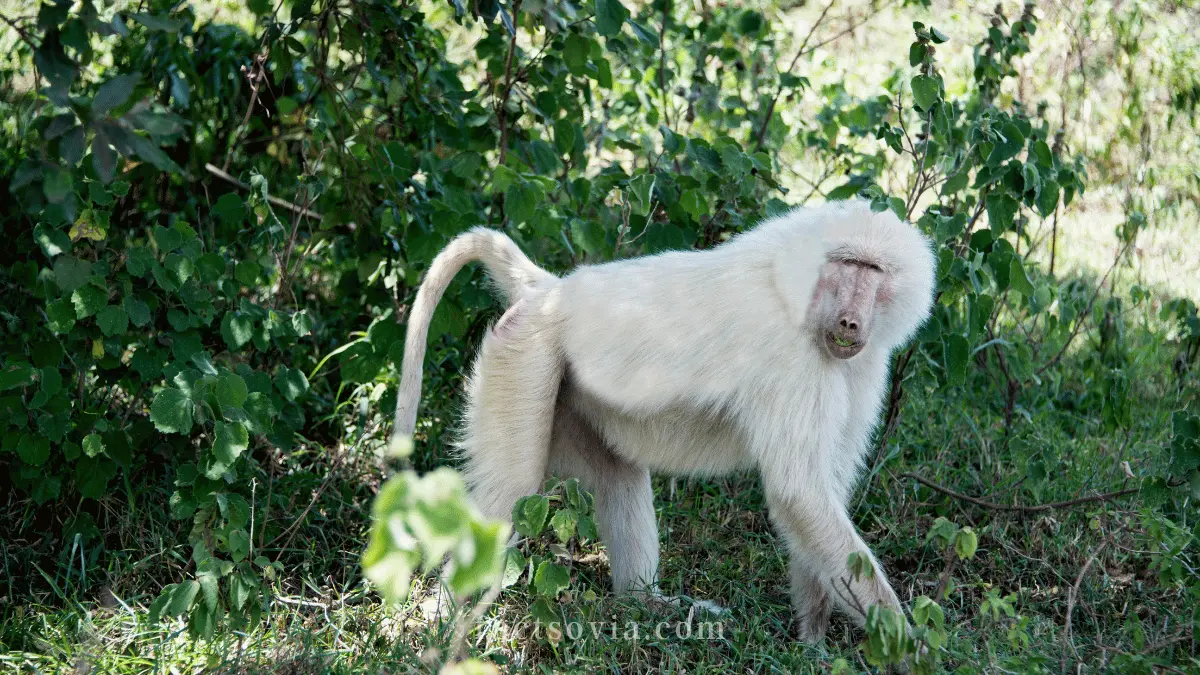We use affiliate links to run our site. When you buy through links on our site, we may earn an affiliate commission, without any added cost to you. Learn more
Albino monkeys are a rare and fascinating occurrence in the primate world. Their all-white fur and distinctive pink eyes make them stand out from their normal-colored counterparts. Though albino monkeys face extra challenges for survival, they remain captivating to observers.
Let’s explore some intriguing facts about these unique monkeys and their condition known as albinism. Understanding albino monkeys can help us better protect and appreciate them.
What Causes Albinism in Monkeys?
Albinism results from inherited genes that disrupt the production of melanin pigment in the body. Without melanin providing color in the skin, fur, and eyes, albino monkeys have pale white coloration.
Inbreeding can increase albinism rates by doubling up on recessive genes. Environmental stresses like extreme heat may also trigger albinism.
Overall, the causes of albinism in monkeys mirror those in humans and other animals. It stems from genetic factors disrupting normal melanin synthesis.
The Effects of Albinism on Monkeys

Lacking protective melanin takes a major toll on albino monkeys. Here are some of the main effects:
- Vision Problems: Albino monkeys often have impaired eyesight because melanin is needed for proper eye development. They may be sensitive to light or have trouble focusing.
- Sunburn & Skin Cancer Risk: Without melanin as a natural sunscreen, albino monkeys are prone to painful sunburns and skin cancer.
- Predation: Albinos’ white fur provides no camouflage in the forest. This makes them a prime target for eagles, big cats, and other predators.
- Social Exclusion: Troops may shun or attack albino monkeys due to their unusual looks. Albinos can become isolated and rejected.
- Mating Difficulties: Potential mates may avoid albino monkeys, seeing their white fur as a sign of poor health. This makes breeding problematic.
- Shortened Lifespans: The risks above combine to lower albino monkeys’ chances of survival, especially in the wild. Few make it to adulthood.
Clearly, albinism imposes severe burdens on affected monkeys. However proper care in captivity can mitigate the difficulties.
Documented Cases of Albino Monkeys
Albino monkeys are exceptionally rare in the wild, with just a handful of documented cases:
- Snowflake: A famous albino monkey studied for decades, Snowflake was a white-headed capuchin born in the wild who lived to age 26.
- Albino Spider Monkey: Discovered in the Honduran rainforest in 2015, this juvenile female was the first documented albino spider monkey.
- Albino Macaques: In 2017, a troop of four albino macaques was spotted at a Thailand nature preserve, a rare sighting.
- Snowflake the Gorilla: Though not a true monkey, the iconic Snowflake was a western lowland gorilla whose 1967 capture sparked interest in primate albinism.
These high-profile cases demonstrate that while uncommon, albino variants can occur in numerous monkey species across the globe. Continued monitoring is important for learning about these unique animals.
Protecting Albino Monkeys
The challenges faced by albino monkeys have not gone unnoticed by conservationists. Some key efforts to protect albino monkeys include:
- Sanctuaries & Zoos: Facilities like Monkey World in the UK take in albino monkeys to shelter them from poachers. Zoos also provide refuge.
- Anti-Poaching Measures: Albino monkeys are highly vulnerable to capture for the exotic pet trade. Wildlife officials crack down on poaching hotspots to counter this threat.
- Public Awareness: Educating the public about albino monkeys fosters appreciation for their rarity and discourages harming them. Young people, especially students, can help promote tolerance.
- Habitat Protection: Guarding monkeys’ forest homes and food sources helps albino and normal monkeys alike survive and thrive.
Though still a work in progress, protecting albino monkeys is an important endeavor for maintaining their unique place in primate ecology. More progress in conservation and public awareness can ensure a future for these fascinating animals.
Key Takeaways on Albino Monkeys
To recap our journey through the world of albino monkeys:
- Albinism stems from disrupted melanin production due to genetic factors. Both inheritance and environment play a role.
- Lack of camouflage and eyesight problems endanger albino monkeys, giving them shorter lifespans.
- Documented cases are very rare, making each albino monkey discovery valuable to science.
- Conservation initiatives aim to guard albino monkeys from poachers and habitat loss wherever they occur.
- Greater public understanding of albino monkeys promotes the humane treatment of these highly vulnerable primates.
Though uncommon, the existence of albino monkeys highlights the diversity of wildlife and gives us a chance to show compassion. With care and luck, these snow-white primates can survive and contribute to the next generation.
Amazon and the Amazon logo are trademarks of Amazon.com, Inc, or its affiliates.
